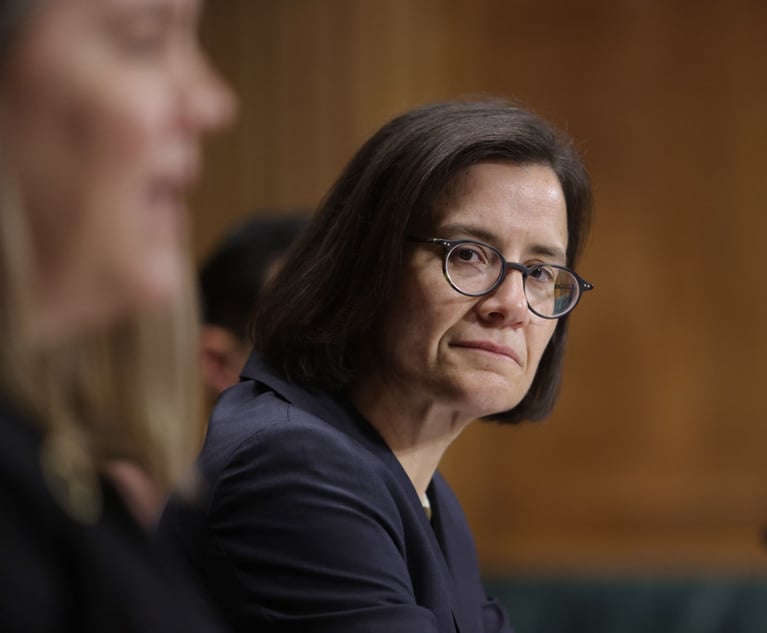In Heavyweight Bout, It's Clients v. Law Firms
The Legal Marketing Association's P3 Conference in Chicago was the scene of a robust debate about legal service delivery and more than a few body blows.
May 18, 2018 at 07:30 AM
9 minute read
In this week's Law Firm Disrupted, we go ringside to narrate a bare-knuckle brawl over a single question: Who is to blame for a lack of change in the legal service delivery model?
I'm Roy Strom, the author of this newsletter, and you can go toe-to-toe with me here: rstrom@alm.com.
➤➤ Would you like to receive The Law Firm Disrupted straight to your inbox? Sign up here.
In one corner, coming in with a combined $91.4 billion in gross revenue; boasting average profits per partner nearing $2 million; and still billing by the hour whenever they can, it's the world's most prestigious law firms.
In the other corner, coming in with a combined revenue that dwarfs that of their challenger; making salaries a portion of their Big Law competition; and still paying by the hour most of the time; it's the world's largest corporations.
In the fight to change the legal service delivery status quo, the question is not who's winning. Instead, it's whose fault is it?
Or at least that was the question posed to four brave competitors (two from law firms; two from legal departments) at the conclusion of the Legal Marketing Association's P3 conference in Chicago this week.
The stipulation of this fight? That the amount of change in legal service delivery is “not nearly as much as the breathless headlines would have you believe.” And that someone is to blame.
Before we get to the fight (the action! the controversy!), first a bit of context: The conference is mostly attended by law firm and legal department professionals in pricing, project management and finance. It is largely free of (practicing) lawyers.
Talking with attendees, I'm told it is something of a “high school reunion” for professionals who have been in the change management game for some time. So forgive them if they are a bit cynical about the current state of legal operations adoption. Their incentives are aligned with change happening more quickly. (And it's all an incentives problem anyway, right?)
Lastly, a stated goal of the “Whose Fault Is It?” panel was to be controversial—something conference organizers as a whole should do more of. Because narrating a fight is much more fun than relating a panel discussion.
Toward that end, the referee of the match was D. Casey Flaherty, who is a consultant to law firms and legal departments despite a headshot curiously evoking a car salesman. He is also a bit of a crowd-pleaser, having at least twice during the P3 conference this week said, “For someone whose brand is 'no bullshit,' I'm at least 30 percent bullshit.”
Nevertheless, his questions hit like indiscriminate body blows, taking to task law firms and clients alike.
Flaherty's first stinger: “How come you still can't tell clients what things will cost?” was directed towards Keith Maziarek. Having had “pricing” or “value” in his title since 2011, Maziarek is something of a grandfather in the legal pricing industry. Showing no respect for that fact, Flaherty told him that most alternative fee arrangements remain “the billable hour with lipstick.” (Shadow billing be damned!)
But this was no fashion show. It was a legitimate fight, scored by audience members voting on their smartphone's P3 app.
In an effort to “baseline” the room (a concept pricing directors should know well), the crowd was asked at the outset who was to blame for stagnation in the legal industry. The highest answer, given by 40 percent of “judges,” was both law firms and clients.
“You cowards!” Flaherty cried.
The second-highest group, 38 percent, said “mostly law firms but also clients.”
“It's anonymous!” Flaherty exhorted.
The crowd was unmoved. And so Maziarek, who works at Katten Muchin Rosenman, came out of the corner with considerable ground to make up alongside his tag-team law firm partner, Purvi Sanghvi, a director of strategic pricing at Paul Hastings and another highly-respected pricing professional.
Maziarek swiftly counter attacked when Flaherty put the blame for pricing uncertainty at the feet of law firms. The “data is really dirty,” Maziarek said, almost as if feigning a jab. Then he went for the hook.
“Also, clients don't know what they want,” he stated straight from the shoulder. “For them to tell us up front what the matter is about and what they care about, that is the challenge. We haven't had that on the industry level with any sort of consistency.”
Well-landed. But the knockout punch of the first round was still to come.
What followed was a complex verbal combination kicked off with a targeted shot from Flaherty to Justin Ergler. A pricing pro at the pharmaceutical giant GlaxoSmithKline plc, Ergler helped make “reverse auctions” a cause célèbre in the legal world: Revered by some of his in-house brethren; reviled by much of the law firm community.
“Why do you still need reverse auctions at your department?” Flaherty inquired like an economics professor talking to an auditorium of freshmen. “Shouldn't you be a price maker rather than a price taker?”
Ergler tried to land a logical point: Each matter is different and a reverse auction creates a one-time marketplace that efficiently discovers price.
“Fair enough!” someone must have thought.
But Ergler knew these judges wanted blood.
“Stop whining about them,” he said about his reverse auctions, which ask law firms to price their work in stages. “Adapt. You know why we keep doing it? Because you keep participating in it.”
From there, the punches came in quick succession.
“Tell Justin why he's wrong,” Flaherty implored Sanghvi.
“You get what you pay for,” she countered, unknowingly leading with the chin.
“Actually, we wish we did.”
There it was.
The knockout, from the stalking horse of the first round, Archer-Daniels-Midland's David Cambria, who outside of verbal jousting is more commonly viewed as some kind of godfather of the legal operations world. (In full disclosure, he was the first to teach this mere scribe about the concept of tracking price data in law firms all the way back in 2015.)
The verbal flares lit up for a few minutes before Flaherty rang the bell. Who won the first round? The judges scored it to Cambria: 40 percent.
In a drawn-out battle, Sanghvi seemed to score most of the rounds. Maziarek, for what it's worth, got dead last in the first round. At the end of the fight, before the free drink coupons were cashed in, the law firms had a larger share of fault in the eyes of judges. Of those in attendance, 51 percent said that law firms are primarily to blame for a legal market that talks a lot but changes little. For those scoring at home; that figure began the day at 38 percent.
If this spectator got a vote on the question of blame for stalled innovation in the legal market (I didn't download the app), he would put it squarely on “both.” And that's only because “neither” wasn't a choice.
At the end of the day, it is true that some law firms have changed their legal service delivery with some clients. And some clients have changed the way they work with some law firms. The fault can't be assigned so generally. The legal market will never be 100 percent flat fees, even if that's what clients wanted. Clients won't always hire the most efficient firm with the most predictable price, even if that's what law firm pricing directors wished.
If there is blame for a lack of change, it exists in the context of particular relationships that one side (most likely the client) wishes would change. And in that case, it is up to them to make a change. In the context of a fight, hit them where it hurts: The pocketbook.
Roy's Reading Corner
The Fight Continues: My colleague Miriam Rozen might as well have been at the P3 conference, as she took on the subject of outside counsel guidelines and how law firms are starting to push back. I heard a range of takes on billing guidelines at P3: Nobody actually reads them. They are way too long. They need to be less rigid and more practical.
I wish I'd heard something like this, from Rozen's story: “Some of the demands clients are making of their outside counsel are so over-broad that they are objectively outrageous,” said New York-based Anthony Davis, who represents lawyers and law firms as a partner in the professional practice group at Hinshaw & Culbertson. ”I talk to general counsel of large and midsized firms all the time, and they are repeatedly being confronted with demands that are so extreme that they are or ought to be unpalatable.”
Billing Hours is My Life: My colleague Brenda Sapino Jeffreys wrote about a Michigan intellectual property partner, Daniel Bliss, who billed 3,600 hours last year. I'm just guessing here, but I doubt he has been asked to work on a flat fee. Some people wanted to judge him. Being close enough to millennial age; I know better. Either way, it's a story worth reading about an interesting guy who sums up his astounding feat this way: “You know what? When the sun shines, you have to make hay.”
That's it for this week! Thanks for reading, and please reach out at rstrom@alm.com if there are any old-timey boxing terms I failed to incorporate. Or, of course, if there is a point to share about the changing nature of the legal market.
This content has been archived. It is available through our partners, LexisNexis® and Bloomberg Law.
To view this content, please continue to their sites.
Not a Lexis Subscriber?
Subscribe Now
Not a Bloomberg Law Subscriber?
Subscribe Now
NOT FOR REPRINT
© 2025 ALM Global, LLC, All Rights Reserved. Request academic re-use from www.copyright.com. All other uses, submit a request to asset-and-logo-licensing@alm.com. For more information visit Asset & Logo Licensing.
You Might Like
View All
Global Lawyer: Big Law Walks a Tightrope But Herbert Smith Freehills Refuses to Lose Its Footing
8 minute readTrending Stories
- 1Silk Road Founder Ross Ulbricht Has New York Sentence Commuted by Trump
- 2Settlement Allows Spouses of U.S. Citizens to Reopen Removal Proceedings
- 3CFPB Resolves Flurry of Enforcement Actions in Biden's Final Week
- 4Judge Orders SoCal Edison to Preserve Evidence Relating to Los Angeles Wildfires
- 5Legal Community Luminaries Honored at New York State Bar Association’s Annual Meeting
Who Got The Work
J. Brugh Lower of Gibbons has entered an appearance for industrial equipment supplier Devco Corporation in a pending trademark infringement lawsuit. The suit, accusing the defendant of selling knock-off Graco products, was filed Dec. 18 in New Jersey District Court by Rivkin Radler on behalf of Graco Inc. and Graco Minnesota. The case, assigned to U.S. District Judge Zahid N. Quraishi, is 3:24-cv-11294, Graco Inc. et al v. Devco Corporation.
Who Got The Work
Rebecca Maller-Stein and Kent A. Yalowitz of Arnold & Porter Kaye Scholer have entered their appearances for Hanaco Venture Capital and its executives, Lior Prosor and David Frankel, in a pending securities lawsuit. The action, filed on Dec. 24 in New York Southern District Court by Zell, Aron & Co. on behalf of Goldeneye Advisors, accuses the defendants of negligently and fraudulently managing the plaintiff's $1 million investment. The case, assigned to U.S. District Judge Vernon S. Broderick, is 1:24-cv-09918, Goldeneye Advisors, LLC v. Hanaco Venture Capital, Ltd. et al.
Who Got The Work
Attorneys from A&O Shearman has stepped in as defense counsel for Toronto-Dominion Bank and other defendants in a pending securities class action. The suit, filed Dec. 11 in New York Southern District Court by Bleichmar Fonti & Auld, accuses the defendants of concealing the bank's 'pervasive' deficiencies in regards to its compliance with the Bank Secrecy Act and the quality of its anti-money laundering controls. The case, assigned to U.S. District Judge Arun Subramanian, is 1:24-cv-09445, Gonzalez v. The Toronto-Dominion Bank et al.
Who Got The Work
Crown Castle International, a Pennsylvania company providing shared communications infrastructure, has turned to Luke D. Wolf of Gordon Rees Scully Mansukhani to fend off a pending breach-of-contract lawsuit. The court action, filed Nov. 25 in Michigan Eastern District Court by Hooper Hathaway PC on behalf of The Town Residences LLC, accuses Crown Castle of failing to transfer approximately $30,000 in utility payments from T-Mobile in breach of a roof-top lease and assignment agreement. The case, assigned to U.S. District Judge Susan K. Declercq, is 2:24-cv-13131, The Town Residences LLC v. T-Mobile US, Inc. et al.
Who Got The Work
Wilfred P. Coronato and Daniel M. Schwartz of McCarter & English have stepped in as defense counsel to Electrolux Home Products Inc. in a pending product liability lawsuit. The court action, filed Nov. 26 in New York Eastern District Court by Poulos Lopiccolo PC and Nagel Rice LLP on behalf of David Stern, alleges that the defendant's refrigerators’ drawers and shelving repeatedly break and fall apart within months after purchase. The case, assigned to U.S. District Judge Joan M. Azrack, is 2:24-cv-08204, Stern v. Electrolux Home Products, Inc.
Featured Firms
Law Offices of Gary Martin Hays & Associates, P.C.
(470) 294-1674
Law Offices of Mark E. Salomone
(857) 444-6468
Smith & Hassler
(713) 739-1250












